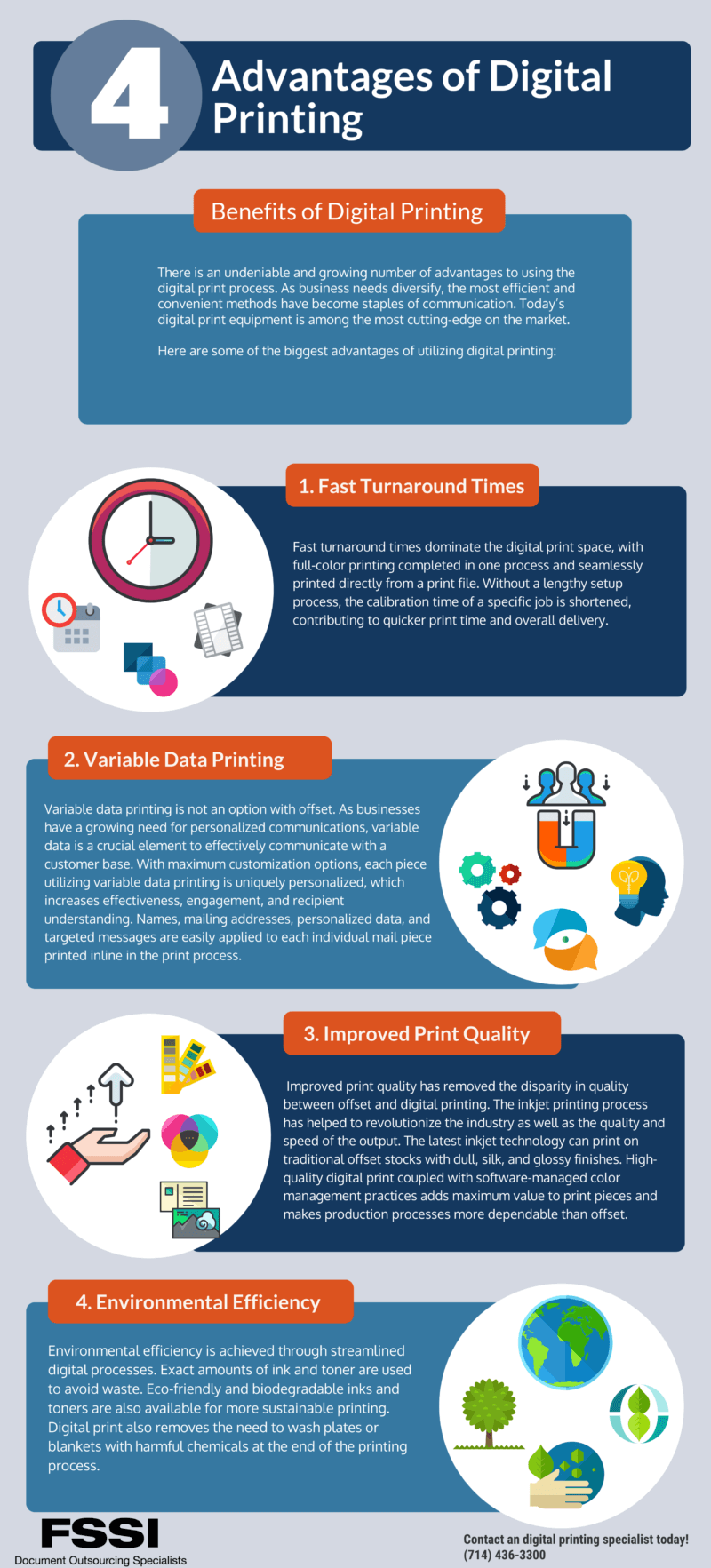The 10-Minute Rule for Digital Printing
The 10-Minute Rule for Digital Printing
Blog Article
What Does Digital Printing Mean?
Table of ContentsThe Best Guide To Digital PrintingWhat Does Digital Printing Do?Some Known Details About Digital Printing The 6-Minute Rule for Digital PrintingDigital Printing for DummiesA Biased View of Digital Printing
Variable data printing, such as straight mail with personalized codes and addresses, is ideally suited for digital printing. Digital quick printing only requires 4 steps of design, testimonial, printing and binding to obtain everything done. Digital quick printing has an unequaled advantage: print on need.According to PMMI, digital printing allows brands and producers to respond promptly to consumer demands while enhancing the supply chain, reducing warehousing cost and waste, and delighting in faster time to market. That all audios terrific, but exactly how does this innovation do all that? The significant differentiator of these modern technologies is that there are no set up fees and no plates with electronic printing.
The Ultimate Guide To Digital Printing
According to Wikipedia, the best difference between electronic printing and standard techniques such as lithography, flexography, gravure, or letterpress - Digital Printing is that there is no requirement to change printing plates in digital printing, whereas in these analog printing techniques home plates are continuously changed. This causes quicker turn-around time and decreases price when making use of electronic printing.
Fast manufacturing implies obtaining your item to market much faster. It likewise indicates it's less complicated and faster to make modifications later, when you alter a dish, include a SKU, or create seasonal product packaging. Digital printing is extremely flexible, so it's very easy to make changes to the bundle style promptly. All of it goes back to home plates.
With conventional printing techniques, short-run printing is just not feasible. Since an excellent design can make or damage your product, electronic printing constantly develops top notch, clear and vibrant graphics each time.
Digital printing is the process of printing digital-based pictures directly onto a variety of media substrates. There is no requirement for a printing plate, unlike with countered printing. Digital documents such as PDFs or desktop computer publishing files can be sent out directly to the digital printing press to publish theoretically, image paper, canvas, material, synthetics, cardstock and other substrates.
Excitement About Digital Printing
According to PMMI, electronic printing permits brands and manufacturers to respond promptly to consumer needs while enhancing the supply chain, lowering warehousing price and waste, and appreciating faster time to market. That all audios fantastic, but how does this technology do all that? The major differentiator of these innovations is that there are no set-up costs and no plates with digital printing.
According to Wikipedia, the best difference in between digital printing and traditional approaches such as lithography, flexography, gravure, or letterpress is that there is no need to change printing plates in digital printing, whereas in these analog printing techniques home plates are continuously replaced. This causes quicker turn-around time and lowers expense when making use of electronic printing.

Digital Printing - Truths
More supply can indicate more waste later on. With standard printing approaches, short-run printing is just not possible. Since a fantastic layout can make or damage your product, digital printing regularly develops top notch, clear and vivid graphics each time. Digital printing on versatile pouches adds the bright, vivid, and accurate graphics that virtually bid customers to connect and touch them.

According to PMMI, digital printing enables brands and manufacturers to respond rapidly to customer needs while boosting the supply chain, reducing warehousing price and waste, and taking pleasure in faster time to market. That all audios wonderful, however exactly how does this modern technology do all that? The significant differentiator of these innovations is that there are no set up fees and webpage no plates with electronic printing.
Rumored Buzz on Digital Printing
According to Wikipedia, the best difference in between digital printing and conventional methods such as lithography, flexography, gravure, or letterpress is that there is no demand to replace printing plates in digital printing, whereas in these analog printing approaches the plates are repetitively replaced. This leads to quicker turn-around time and decreases cost when utilizing electronic printing.
Speedy production implies getting your her explanation item to market faster. It additionally suggests it's easier and faster to make adjustments later on, when you alter a recipe, add a SKU, or produce seasonal packaging. Digital printing is extremely flexible, so it's easy to make adjustments to the plan style quickly. It all goes back to home plates.

What Does Digital Printing Do?
Digital printing is the procedure of printing digital-based photos directly onto a range of media substratums. There is no demand for a printing plate, unlike with offset printing. Digital data such as PDFs or desktop computer publishing data can be sent directly to the electronic printing press to print on paper, photo paper, canvas, fabric, synthetics, cardstock and various other substrates.
Report this page